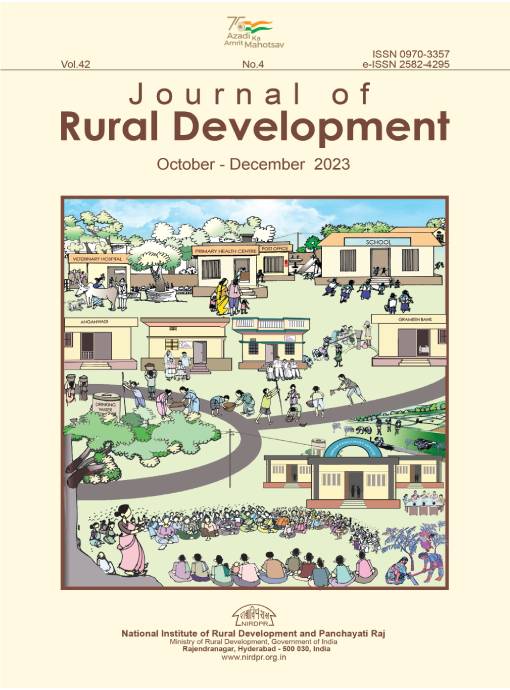Impact of Family Livelihood on the Spatial Organisation of Indigenous Housing in Boshrouye, Iran
DOI:
https://doi.org/10.25175/jrd/2023/v42/i4/152370Keywords:
Indigenous Housing, Livelihood, Spatial Configuration, Space Syntax, Boshrouye, Iran.Abstract
Indigenous housing has been created to cater to the cultural, social, and economic needs of society as well as its family livelihood. Boshrouye City, located in South Khorasan Province, Iran, has a special livelihood system with valuable examples of indigenous housing. The present study aims to investigate the effects of the family livelihood and its associated activities on the spatial organisation of housing. For this purpose, 20 samples of indigenous houses were selected non-randomly and investigated based on the space syntax theory. Plans of houses were analysed using UCL Depthmap software and then evaluated through Convex and Isovist map analyses. The research method employed was the interpretive method. The results of the study indicate that the model of family livelihood has a significant impact on the spatial organisation of housing in Boshrouye City. This model has employed physical means, including the creation of new spaces and changing the role and configuration of spaces to protect the privacy of occupants. This privacy is one of the cultural requirements of this region.
Downloads
Downloads
Published
How to Cite
Issue
Section
References
Afshari, M.; Sh. Pourdehimi, and B. Saleh Sedigh (2015) Adaptation of the Environment to the Way of Human Life (A Theoretical Framework, A Case Study), Housing and Rural Environment, 152: 3-16.
Altman, I. (1975) The Environment and Social Behavior, A. Namaziyan. (Ed.), Shahid Beheshti University Press, Tehran
Brown, B. B., and I. Altman (1983) Territoriality, Defensible Space and Occupantial Burglary: An Environmental Analysis. Journal of Environmental Psychology 3(3): 203-220.
Byun, Na. and J. Choi (2016) A Typology of Korean Housing Units: In Search of Spatial Configuration, Journal of Asian Architecture and Building Engineering 15(1): 41-48.
Chambers, R. (2005) Ideas for development. Earth Scan Publication, London, Sterling VA.
Chermayeff, S. and C. Alexander (1963) Community and Privacy: Toward a New Architecture of Humanism. Doubleday.
Dunn, J. R. (2000) Housing and Health Inequalities: A Review and Prospects for Research, Housing Studies 15 (3): 341-366.
Greenbaum, P. E. and S. D. Greenbaum (1981) Territorial Personalization: Group Identity and Social Interaction in a Slavic-American Neighbourhood. Environment and Behavior 13(5):574-89.
Groat, L. N. and D. Wang (2013) Architectural Research Methods. John Wiley & Sons.
Hall, E.T. (1966) The Hidden Dimension, Anchor, Hamburg, Germany.
Hanson, J. (2003) Decoding Homes and Houses. Cambridge University Press.
Helmor, C. and N.Sing (2001) Sustainable livelihood: Building on the Wealth of the Poor. Bloomfield: Kumarin Press.
Hillier, B. and J. Hanson (1984) The Social Logic of Space; Cambridge University Press: Cambridge, UK.
Khakpour, M.; M. Ansari; A. S. Mahdavi, and M. Tavousi (2015) Cultural-Social Features of Indigenous Housing. Housing and Rural Environment 149: 3-14.
Kavian, M. and G. Gholami (2017) Factory or Work and Home; the Study of the Concept of Work and Production in the Formation of Iranian Historical Houses in Boshrouye. Journal of Warm and Dry Climate Architecture, 5 (5): 101-18.
Lawrence, R. J. (1987) Housing, Dwellings and Homes: Design Theory, Research and Practice. New York: John Wiley & Sons.
Madahi, S. M. and G. H. Memarian (2017) A Space Syntax Analysis of Vernacular Dwelling Configuration (Case Study: Boshrouye City). Journal of Housing and Rural Environment, 35 (156):49-66.
Madahi, S. M. and G. H. Memarian (2019) Reading the Link of Spatial Organisation of House and Lifestyle in Vernacular Architecture (Case Study: Boshrouye). Journal of Housing and Rural Environment, 37 (164):69-84.
Madahi, S. M.; G. H. Memarian; M. Bemani Naeini and T. Khodadadi Fakhr Abadi (2017) A Formal Analysis of Houses in Vernacular Architecture of Khorasan; Case Study: Boshrouye City in Pre-Pahlavi Period. Journal of Housing and Rural Environment, 36 (159):63-78.
Marcus, C. C. (1997) House as a mirror of self. Berkeley, CA: Conari Press.
Newman, O. (1973) Architectural Design for Crime Prevention. National Institute of Law Enforcement and Criminal Justice Washington, DC.
Norberg-Schultz, C. (1974) Meaning in Western Architecture Rizzoli, New York.
Norberg-Schultz, C. (1984) The Concept of Dwelling on the Way to Figurative Architecture. Rizzoli International Publications, USA.
Papoli Yazdi, M. H., and F. Vosoughi (1996) Rural Housing, Culture and Development, Geographical Research 41(11): 26-46.
Pastalan, L. A. (1970) Privacy as an Expression of Human Territoriality. Spatial Behavior of Older People: 88-101.
Rapaport, A. (2005) Culture Architecture and Design, Locke Science Publishing Co., Inc., Chicago, USA.
Rapaport, A. (2001) Theory, Culture, and housing, Journal of Housing, Theory and Society 17(4): 145-165.
Rapaport, A. (1969) House Form and Culture. New Delhi: Prentice-Hall of India Private Ltd.
Rostami, S., A. A. Heidari, and Y. Peyvastehgar (2021) Analysis of the Role of Livelihoods in the Form of Rural Settlements Case Study: Bustano Village of Bandar Abbas City. Regional Planning, 11(42), 204-219.
Scott, MM. (2005) A Powerful Theory and a Paradox: Ecological Psychologists after Barker. Environment and Behavior 37(3): 295-329.
Sommer, R. and F. D. Becker (1969) Territorial Defence and the Good Neighbor. Journal of Personality and Social Psychology 11(2): 85.
Tames, E. (2004). Use, Appropriation and Personalization of Space in Mexican Housing Projects and






